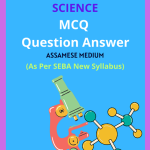Class 7 Science MCQ Chapter 18 Waste Water Story Solutions in English Medium, Class 7 Science Multiple Choice Question Answer in English to each chapter is provided in the list so that you can easily browse throughout different chapters Class 7 Science MCQ Chapter 18 Waste Water Story Notes and select need one.
Class 7 Science MCQ Chapter 18 Waste Water Story
Also, you can read the SCERT book online in these sections Class 7 Science Objective Type Solutions by Expert Teachers as per SCERT (CBSE) Book guidelines. These solutions are part of SCERT All Subject Solutions. Here we have given Assam Class 7 Science MCQs Solutions in English for All Subject, You can practice these here.
Waste Water Story
Chapter – 18
| MCQ |
1. Chlorine is used in municipal water treatment plants to:
(a) Change the taste of water.
(b) Prevent evaporation.
(c) Kill the harmful microorganisms.
(d) Prevent sedimentation.
Ans: (c) Kill the harmful microorganisms.
2. What is wastewater?
(a) Clean water used for drinking.
(b) Water used in homes, industries, and agriculture.
(c) Water that is stored underground.
(d) Freshwater from rivers.
Ans: (b) Water used in homes, industries, and agriculture.
3. The aerobic bacteria can be grown in clarified water by:
(a) Filtration.
(b) Sewage.
(c) Aeration.
(d) Sedimentation.
Ans: (c) Aeration.
4. What is sewage?
(a) Clean water for agricultural use.
(b) Liquid waste generated in human activities.
(c) Solid waste disposed of in landfills.
(d) Treated water used for drinking.
Ans: (b) Liquid waste generated in human activities.
5. Which of the following is not an inorganic impurity present in sewage?
(a) Nitrate.
(b) Phosphorus.
(c) Urea.
(d) Metal salt.
Ans: (c) Urea.
6. Where is wastewater treated?
(a) In a sewage treatment plant.
(b) In an underground reservoir.
(c) In natural water bodies.
(d) In agricultural fields.
Ans: (a) In a sewage treatment plant.
7. Which of the following organisms produce biogas from sludge in the digester tank of a wastewater treatment plant?
(a) Anaerobic bacteria.
(b) Fungi.
(c) Aerobic bacteria.
(d) Protozoa.
Ans: (a) Anaerobic bacteria.
8. What are the by-products of wastewater treatment?
(a) Freshwater and soil.
(b) Sludge and biogas.
(c) Clean air and energy.
(d) Pesticides and fertilizers.
Ans: (b) Sludge and biogas.
9. Which of the following is not a VITA water-borne disease?
(a) Cholera.
(b) Tuberculosis.
(c) Typhoid.
(d) Dysentery.
Ans: (b) Tuberculosis.
10. Why is an open drain system harmful?
(a) It causes soil erosion.
(b) It breeds flies, mosquitoes, and disease-causing organisms.
(c) It provides clean water for irrigation.
(d) It supports natural vegetation.
Ans: (b) It breeds flies, mosquitoes, and disease-causing organisms.
11. Which of the following properties of pure water is correct?
(a) It should not contain any suspended impurity.
(b) It should not contain any harmful germs.
(c) Both (a) and (b).
(d) None of the above.
Ans: (c) Both (a) and (b).
12. Find the one which is a dried-up river:
(a) Godavari.
(b) Ganga.
(c) Mahanadi.
(d) Arveri.
Ans: (d) Arveri.
13. “By providing clean water and sanitation to the poorest people on the planet, we can reduce poverty and suffering and ensure education for all children.” The above words are given by:
(a) UNO.
(b) UNICEF.
(c) UNESCO.
(d) WHO.
Ans: (b) UNICEF.
14. Which of the two uses of sludge is correct?
(a) It is used as a measure to enrich the soil with humus and nutrients.
(b) It is used to produce biogas which is used as a fuel. Biogas can also be used to generate electricity.
(c) Both (a) and (b).
(d) None of the above.
Ans: (c) Both (a) and (b).
15. What are the uses of treated water which is obtained from sewage treatment plants?
(a) It is used for irrigating fields, lawns, and for aquaculture.
(b) In Kolkata, the treated water is used for fisheries and growing crops and vegetables.
(c) Both (a) and (b).
(d) None of the above.
Ans: (c) Both (a) and (b).

Hi! my Name is Parimal Roy. I have completed my Bachelor’s degree in Philosophy (B.A.) from Silapathar General College. Currently, I am working as an HR Manager at Dev Library. It is a website that provides study materials for students from Class 3 to 12, including SCERT and NCERT notes. It also offers resources for BA, B.Com, B.Sc, and Computer Science, along with postgraduate notes. Besides study materials, the website has novels, eBooks, health and finance articles, biographies, quotes, and more.



